Contributory members are able to log private notes and comments about each site
Sites Anne T has logged. View this log as a table or view the most recent logs from everyone
St Michael (Lowther)
Trip No.68 Entry No.4 Date Added: 7th Apr 2018
Site Type: Ancient Cross
Country: England (Cumbria)
Visited: Yes on 5th Apr 2018. My rating: Condition 3 Ambience 3 Access 5
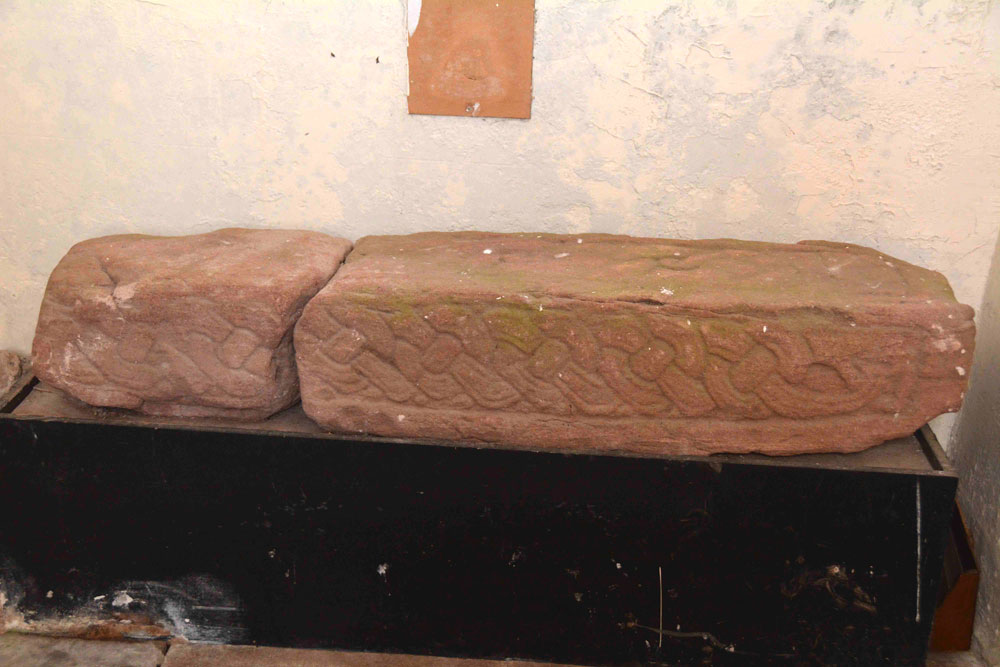
St Michael (Lowther) submitted by Anne T on 7th Apr 2018. This grave cover, now broken into two parts, can be found against the western wall of the porch. It is recorded as AS Corpus Lowther 07a-b and is dated to the 10th century.
(View photo, vote or add a comment)
Log Text: Ancient Cross and hogback fragments, Lowther: We arrived here eager to see the hogback and grave covers detailed on the Corpus of Anglo Saxon Stone Sculpture Volume II, but on arriving at the church, the door appeared to be locked. There were a few broken panels in the south window of the porch, so I resorted to trying to take photos through the window, but there was no light. I called up the Corpus on my phone to see what might be in the churchyard rather than inside the church and came up with Lowther 10, which is built into the retaining wall of the churchyard where it drops down to the River Lowther, 9m from the south west corner of the church. Andrew walked all the way round, whilst I stayed in the churchyard marking the spot, but despite having the Corpus photograph, this stone appeared to be too worn to identify.
In disappointment, I went and rattled at the church door again, a little more boisterously than before and as I let the handle go, heard the latch click and the door came open. We made our way inside the church. There are supposed to be a number of fragments in the porch, but only found 2 that are recorded on the Corpus.
There are three more fragments tucked away against the west wall of the north transept, and I had to go and get my large flash gun to take photographs. Only two of these are recorded on the Corpus.
This is a really strange church. Despite its size, it feels more like a mausoleum rather than a church, and I was glad to get out into the sunshine to find the cross in the churchyard.
Castlesteads (Yanwath Wood)
Trip No.68 Entry No.7 Date Added: 7th Apr 2018
Site Type: Ancient Village or Settlement
Country: England (Cumbria)
Visited: Yes on 5th Apr 2018. My rating: Condition 2 Ambience 3 Access 3
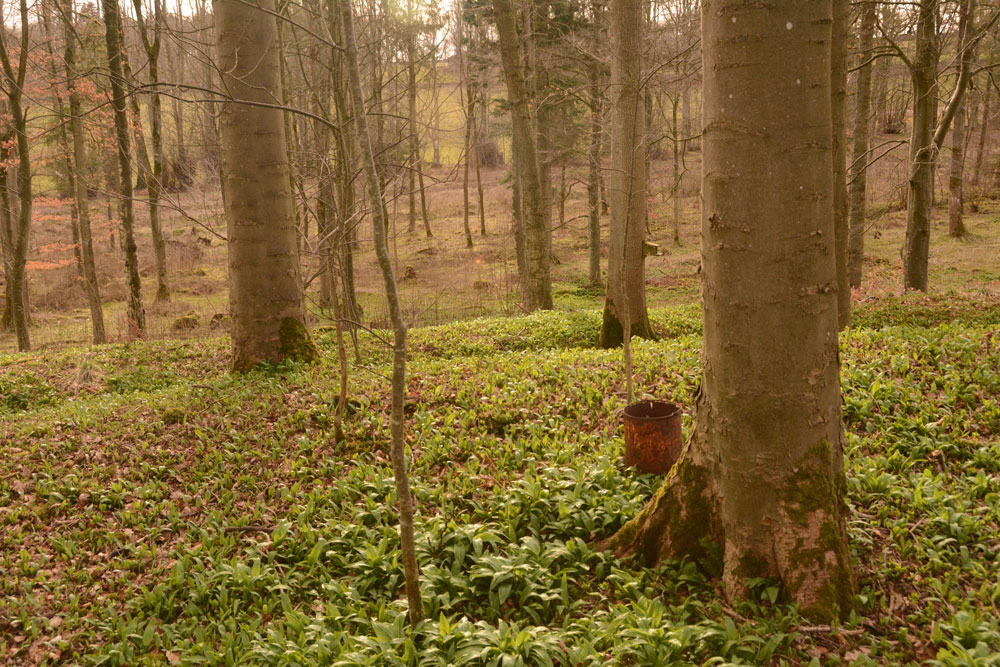
Castlesteads (Yanwath Wood) submitted by Anne T on 7th Apr 2018. Standing just inside the inner bank on the north western side of the enclosure looking across a ditch and two banks.
(View photo, vote or add a comment)
Log Text: Castlesteads (Yanwath Woods), Cumbria: This hillfort/enclosure is a pleasant stroll away from St. Michael’s Church and Lowther Castle, along footpaths and forest tracks, crossing the River Lowther either on the road or the footpath. After crossing the river, we followed the forest track north then to the west when the track split some 100 metres or so after the river crossing. The track following the river was full of dog walkers from the nearby holiday/caravan park, although heading up into the forest, it was peaceful and calm.
This was a very strange site, as there is higher ground to the north/north west of this enclosure. There were some huge boulders within the interior of the enclosure. Some made up what seemed to be wall lines, others just seemed scattered about.
The northern part of the enclosure seems to have been clipped by the construction of the forest track, and this has removed the outer banks and ditches on this side.
Tullie House Museum
Date Added: 29th Apr 2018
Site Type: Museum
Country: England (Cumbria)
Visited: Yes on 20th Apr 2018. My rating: Condition 4 Ambience 4 Access 5
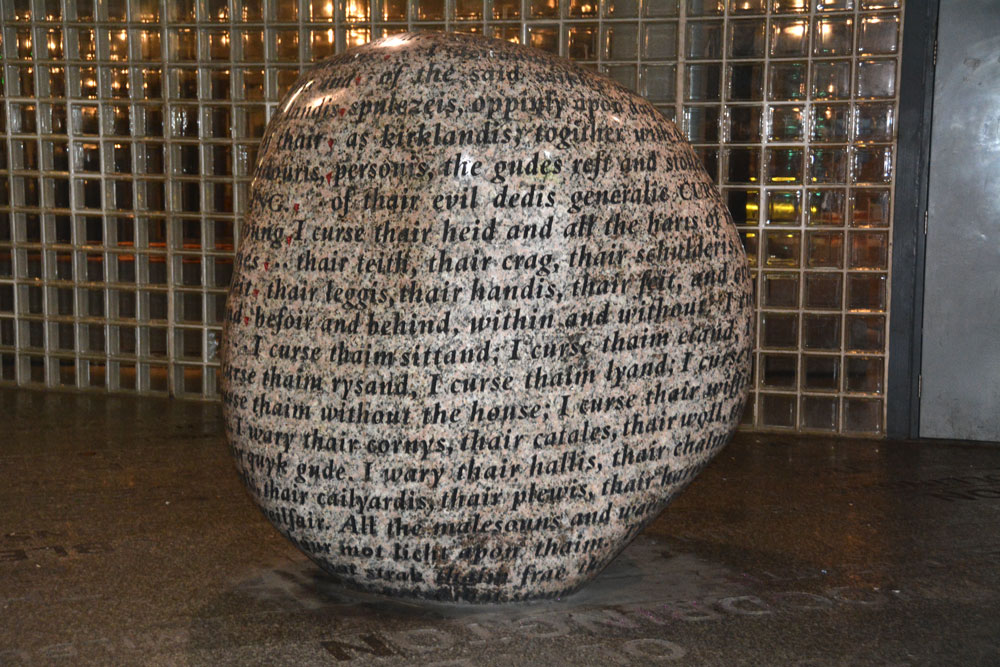
Tullie House Museum submitted by Anne T on 19th Sep 2017. Walking around the Cursing Stone - a bit difficult to photograph in what is largely a dimly lit pedestrian underpass with bright lights illuminating a few spots and shining off the stone.
(View photo, vote or add a comment)
Log Text: Tullie House Museum, Carlisle: We went to see the copy of the Bewcastle Cross and the Anglo Saxon cross fragments I'd seen photos of some years ago. The Bewcastle Cross copy no longer stands in the main entrance lobby, but is now in storage, and there are only a couple of rock art panels on display, along with Celtic gods (all displayed behind glass).
There was a very interesting video, and a display of associated artefacts, of the Langdale Axe factory.
A small museum, but interesting, even the Roman gallery in the basement, which has lots of interactive displays for children.
We bought a year pass for £10 each, which means we can return at any time for free until the end of April 2019. I've asked permission to go back to use their learning resource to find out more about the Celtic god sculptures.
Askerton Park
Trip No.69 Entry No.1 Date Added: 5th May 2018
Site Type: Ancient Village or Settlement
Country: England (Cumbria)
Visited: Yes on 23rd Apr 2018. My rating: Condition 2 Ambience 3 Access 4
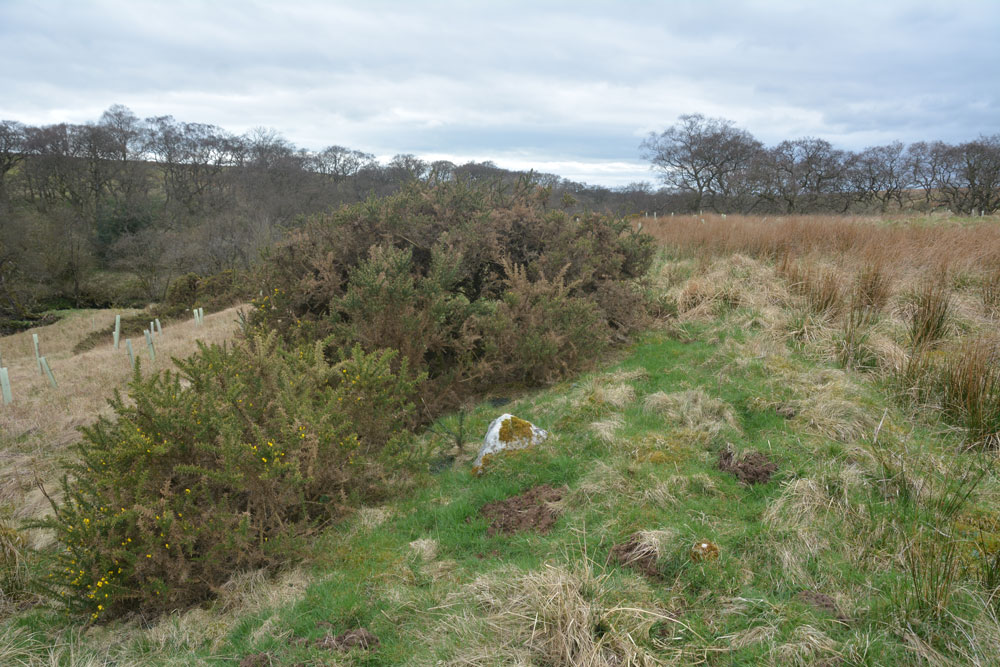
Askerton Park submitted by Anne T on 5th May 2018. Right in the middle of the settlement and just a little to its eastern side, there is a wide stoney bank which looks as if this may have been part of the main dwelling described in the Pastscape record. All around here the moles had been very active, and many shards of pottery had come to the surface.
(View photo, vote or add a comment)
Log Text: Askerton Park Settlement: This is marked on the OS map, so we stopped at the northern end of Parkgate Bridge, where there is room to pull off the road and put on our wellies. We let ourselves in through the gate and tramped over the fields, entering the settlement from its north eastern side.
This settlement is fascinating, as its basically on a promontory between the Cam Back and Melefarm beck. Hollow ways run from the eastern part of the settlement to the Cam Beck, and there is another hollow way which picks up almost half way across the settlement, leading to Cam Beck. Following the latter trackway to the burn, there are the obvious remains of a cairn.
It was really interesting walking across the tops of the enclosure banks, which stood out a brighter green with shorter grass than the surrounding wheat-coloured taller stalks. There were lots of stones in the banks. The moles had had a field day, and I picked up a couple of the many pieces of pottery that had come to the surface of a mole hill (I wasn't certain they were pots until I got home and saw the inclusions and felt the lightness of the pot as opposed to some odd shaped stones).
Priest's Well (Bewcastle)
Trip No.69 Entry No.3 Date Added: 6th May 2018
Site Type: Holy Well or Sacred Spring
Country: England (Cumbria)
Visited: Yes on 23rd Apr 2018. My rating: Condition -1 Ambience 3 Access 4
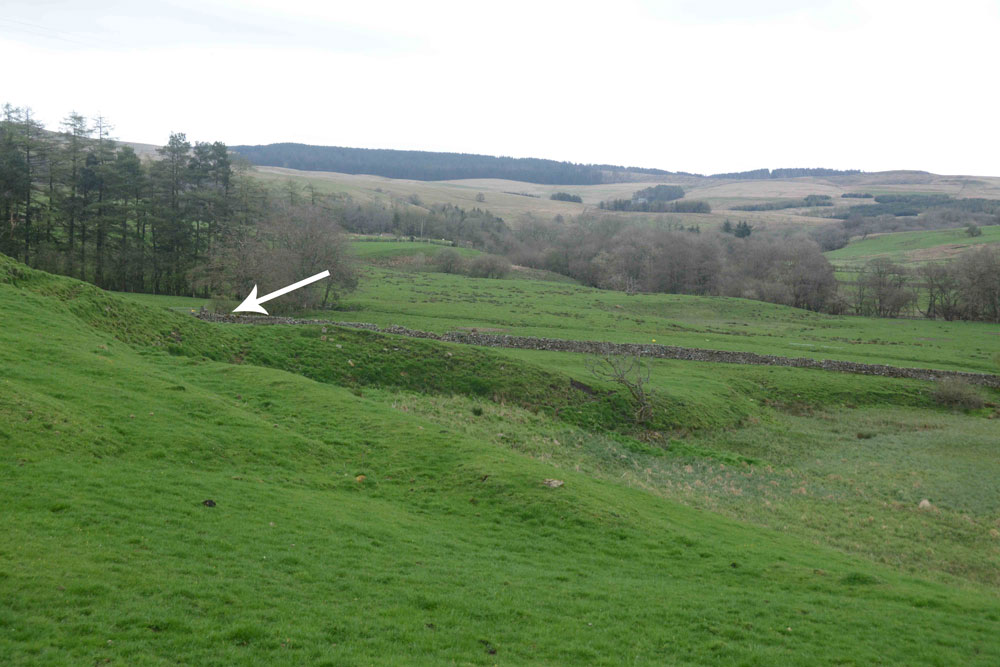
Priest's Well (Bewcastle) submitted by Anne T on 6th May 2018. This photograph was taken from the south eastern corner of the churchyard, the current landforms seeming to indicate that a spring once issued from here, disappearing into the Kirk Beck below.
(View photo, vote or add a comment)
Log Text: Priest's Well, Bewcastle (site of): As the ground was far too boggy to go and see the three cairns to the west of Parkgate Bridge, I found this well marked on the OS map, so we decided to go and see it. Arriving at St. Cuthbert’s and the Bewcastle Cross, we orientated ourselves with the map to find the well is actually on private farmland. The farmer was busy driving around the field in his tractor, so we decided we could probably see the well from the eastern end of the churchyard.
We did see some indication of where the site of the well was, but there was no well housing or water flowing. I could find very little information on this well, apart from the mention in the Old Cumbria Gazetteer, which says it is a spring. As I finished photographing the site of where the well probably was, drizzle started to hurtle down.
Long Stone (Barcombe Hill)
Trip No.70 Entry No.2 Date Added: 6th May 2018
Site Type: Ancient Cross
Country: England (Cumbria)
Visited: Yes on 5th May 2018. My rating: Condition 3 Ambience 4 Access 4
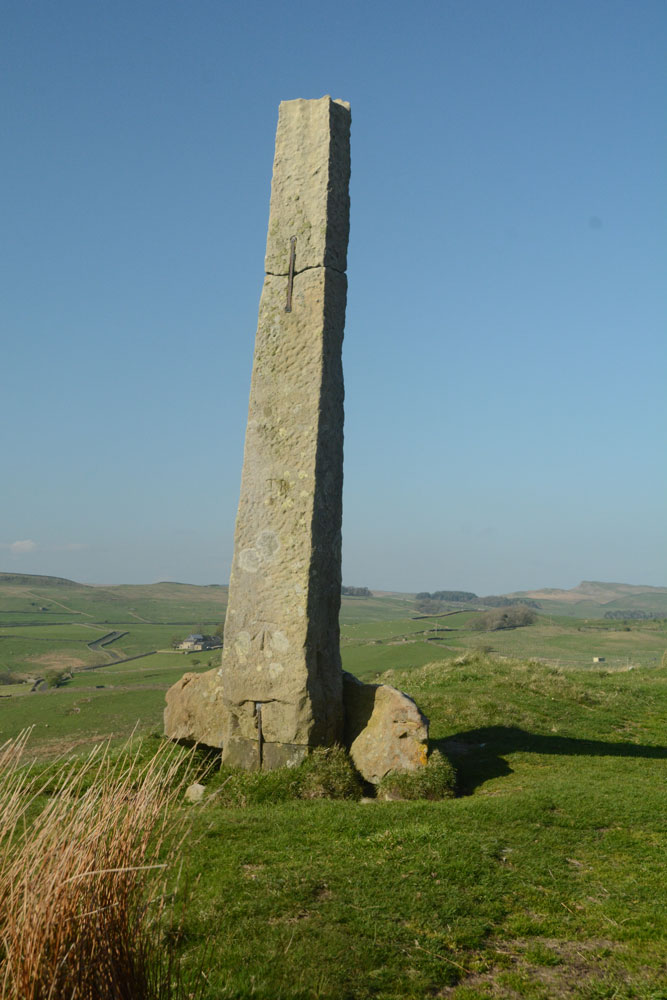
Long Stone (Barcombe Hill) submitted by Anne T on 6th May 2018. The Long Stone from the west, looking back towards Barcombe Iron Age defended settlement.
(View photo, vote or add a comment)
Log Text: The Long Stone, Barcombe Hill: we always thought this was a modern marker stone, sitting high above Stane Way. We also thought it was difficult to get to. Not so. There are well mown grass trackways that lead from Barcombe Iron Age Defended Settlement/Roman Signal Station, as well as from the Trig Point on Barcombe Hill. We approached from the trig point, which is higher than this stone and the settlement.
The whole stone and base are held together with large metal/iron rivets. The base looks as if it has been broken into two, and one half has been taken away. The top of the cross appears rounded upwards at the four corners, as if a cross head (or similar) was mounted on top.
The more time I spent here, the more I was convinced this was an old cross. What a location! With Vindolanda below, it is certainly a very prominent spot.
St Mungo's Church (Bromfield)
Trip No.81 Entry No.1 Date Added: 15th Aug 2018
Site Type: Ancient Cross
Country: England (Cumbria)
Visited: Yes on 9th Jul 2018. My rating: Condition 3 Ambience 4 Access 4

St Mungo's Church (Bromfield) submitted by Anne T on 10th Jul 2018. The dark red semi-circular stone is (the remains of) AS Corpus Bromfield 04, a 10th century hogback, as seen from the inside of the south porch. Located above the main door of the church, we stood for ages trying to make out the original hogback. The wavy edge at the top of this dark red sandstone is the only clue. According to the AS Corpus photos, the hogback can be better seen from inside the church, but the church was locked, so we were unable to see.
(View photo, vote or add a comment)
Log Text: Hogback and ancient crosses at St. Mungo's Church, Bromfield: Our first stop of the day. This is clearly an ancient village.
The church was locked, so the only stone we could see was in the porch – AS Corpus Bromfield 04. From the Corpus image, the top of the hogback looks clearer from the inside of the church, but of course we couldn’t get in.
After walking back from the well, I stopped to look at the hideous memorial in the southern part of the churchyard and noticed that it was built on what looked like the base of an old village/medieval cross. I haven’t been able to find anything out about this – it’s not mentioned in any literature I’ve currently come across – but suddenly it became more interesting!
We did try and find High Aketon Farm to see AS Corpus Bromfield 03, but couldn’t find it on the paper OS map and an internet search pulled up nothing. We decided to move on to the next location.
I’m going to try and contact the vicar to see if we can arrange entry into the church for sometime in mid-August.
Blennerhasset Cross
Trip No.81 Entry No.6 Date Added: 10th Jul 2018
Site Type: Ancient Cross
Country: England (Cumbria)
Visited: Yes on 9th Jul 2018. My rating: Condition 3 Ambience 4 Access 5
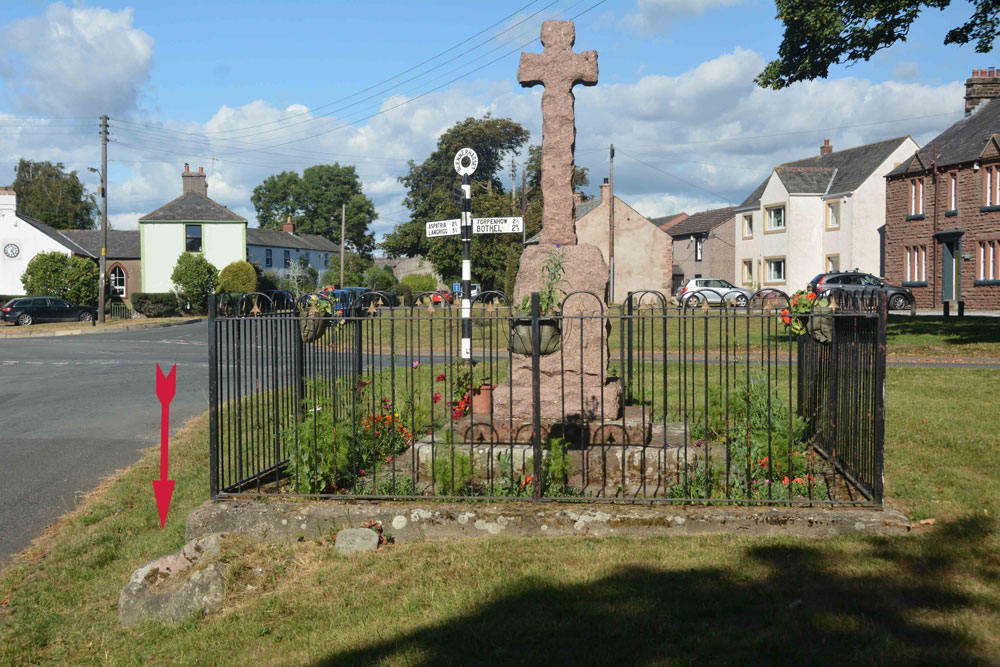
Blennerhasset Cross submitted by Anne T on 10th Jul 2018. The memorial, with discarded socket stone to the bottom left (highlighted by the red arrow), taken from the western side.
(View photo, vote or add a comment)
Log Text: Three crosses in one, Blennerhasset, Cumbria: Having been to four churches to see Anglo Saxon carved stones, and only found one unlocked, I wanted to stop and see the 'cross' marked on the OS map in this small village. This really is a stunning medieval village, and I wish we’d had more time to wander round and admire the old buildings. There was a lovely bridge over the river, although there was a children’s picnic and football match going on next to it, so we didn’t disturb them. There were two information boards outside the school, but neither mentioned the cross. Despite it looking like a war memorial, I wandered across only to find the base of the medieval cross and the discarded socket stone. Brilliant!
St Mungo's Dearham
Trip No.81 Entry No.5 Date Added: 16th Aug 2018
Site Type: Ancient Cross
Country: England (Cumbria)
Visited: Yes on 9th Jul 2018. My rating: Condition 3 Ambience 4 Access 5
St Mungo's Dearham submitted by coin on 29th Mar 2017. The Viking Cross at Dearham
(View photo, vote or add a comment)
Log Text: Ancient Crosses and a Norman font, St Mungo's Church, Dearham: After having been to two other churches which had been firmly locked, this church was, thankfully open and very welcoming.
The church was packed full of knitted scenes from the bible, jewellery and books. We missed the Adam Stone, but are going back on 14th August, and have asked for permission to get into the vestry to see AS Corpus Dearham 03, a fragment of a wheel headed cross built into the wall.
We had to move quite a few items from the west window to photograph AS Corpus Dearham 02, and it took us ages to get everything back!
The Norman font, apparently carved from the cushion capital of a column, was really interesting.
There was no church guide book, although there was a postcard (30p) and a display board, which I took a few photos of.
The first notes on the display board say: “There can be no doubt that Dearham had a church during the Dark Ages, following the withdrawal of Roman Forces from Britain. Many pre-Norman sculptured stones displayed in the present church provide evidence that Christianity was prevalent during Anglo Saxon and Viking times. The Reverend William Slater Calverley was vicar of Dearham from 1877 until 1885 and was responsible for uncovering and displaying many of these stones. He worked tirelessly on restoring the church to much of the originality as possible during his period of incumbency. In 1880 it was recorded that he did not know to whom the church was dedicated, the original dedication having been lost. It was rededicated in 1935, as a result of the inspiration of the Reverend Canon Malcolm D. Grieve, to St. Mungo, a Scottish saint whose real name was St. Kentigern. In 1937 Canon Grieve was also responsible for the addition inside the church building, of a side chapel dedicated to the Holy Name. It stands at the east end of the north aisle.”
There is a section on the display called: “A brief look at the history of St. Mungo’s. It is believed that the original stone church dating back to the early 1100s was about 48 feet long in the shape of a long, low tunnel. During the Norman period parts were added and extended later in the Early English period. The tower was added probably early 14th century. The porch was also an addition to the original building covering the Norman doorway. The north aisle was a completely new addition during the 1882 restoration when Mr. Calverley enlarged the church. The vestry, at the east end, is an extension to the north aisle, the date being cut into the pillar of an arch. Built in the north wall of the vestry is the head of the “Kenneth Cross”. It was found near the east end of the church and built into the vestry wall curing restoration. The stained glass window behind the altar was given by Mr. John Wilson of Dearham and built in at the time of the 1882 restoration. The bell, which weights almost half a ton, was given by Colonel Sewell, whose family were seated at Brandlingill end of Hayborough. The ancient windows, dating back probably to 1150 were removed during the 1815 restoration and sadly lost to this day! Had they been lying about in 1880 Rev. Calverley would have restorated them to their rightful place, when he in turn removed the sash windows and inserted new ones fashioned in the style of the originals.”
The display says: “The magnificent wheel head cross (Viking cross) stands 5ft 4ins high and is carved with “Yggdrasil”, the Norse tree of the universe. It stood in the churchyard until 1900 and then brought into the church and placed in front of the organ.”
Another section reads: “The treasures of the Church include two stones found during 1882 restoration work. Standing 4ft high is the Adam stone, dating from AD 900, which depicts the Fall and Redemption of Man, with Adam and Eve hand in hand above a serpent. The Kenneth Cross shows the legend of the 6th century hermit, S. Kenneth, who was lame from birth and after his baptism cast away in a coracle. He was saved from the gales, and brought up by seabirds.”
The small door leading up into the tower was open, with a very narrow set of steps leading up. Not even Andrew fancied venturing up.
St Mary's Well (Wreay)
Trip No.90 Entry No.1 Date Added: 31st Jul 2018
Site Type: Holy Well or Sacred Spring
Country: England (Cumbria)
Visited: Yes on 30th Jul 2018. My rating: Condition 3 Ambience 4 Access 4
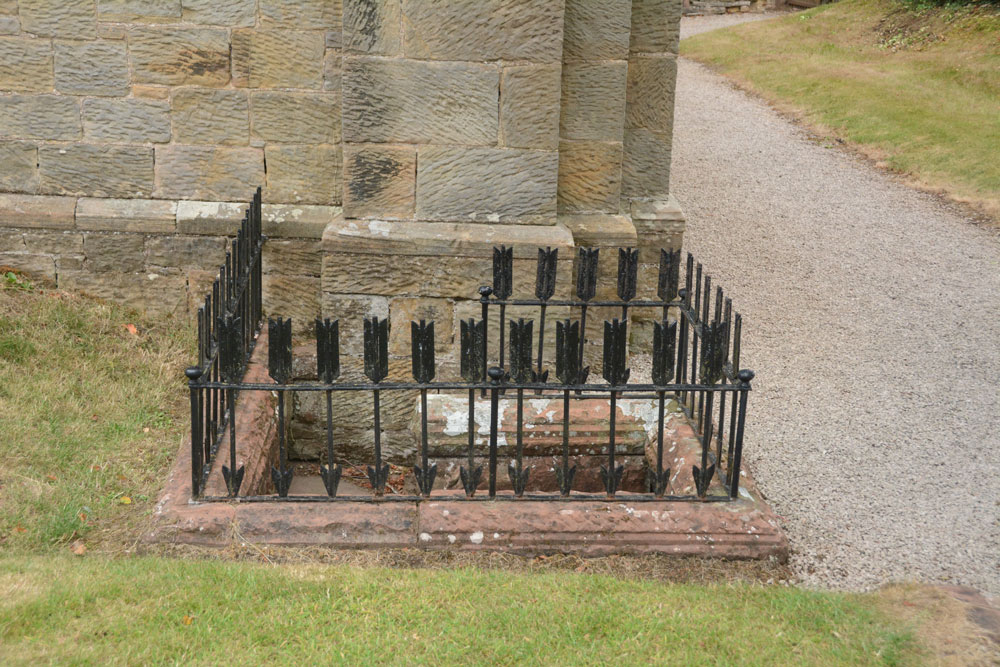
St Mary's Well (Wreay) submitted by Anne T on 31st Jul 2018. Approaching the well, with its curious railings made up of arrows, which represent 'death' according to the leaflets in the church.
(View photo, vote or add a comment)
Log Text: St Mary's Well and copy of the Bewcastle Cross, Wreay: This is a delightful little village, with some very old houses. The church is very easy to find, right in the middle of the village, opposite the colourful school, with plenty of parking on the streets nearby.
This well is to the southern side of the exterior western wall, although it has been dry for some considerable time. The well spout, in the form of an animal head, is quite superb and unusual (like the gargoyles on the roof line of the church).
The Holy Wells of Cumbria booklet (page 14) describes this well as:
Location: Approx. 9 miles south of Carlisle. The well is found by the front wall of St. Mary’s Church, Wreay.
Description: Although it is unknown whether this was a holy well, the highly unusual and attractive church is well worth a visit in itself. The original church dates back to 1319, and was rebuilt by Sarah Losh in 1840-42 – see also well 4 at Brisco – in memory of her sister Catherine and her parents. Italian in style, it is full of highly original and deeply symbolic carvings in wood and stone, many representing in forms from nature the eternal contrast between light and dark, or life and death. The well outside is a curious construction surrounded by cast iron arrows. Dog-leg stone steps lead down into the well, where water flows from a lion’s (or dog’s head) into a aquare stone piscina blessed with a solitary green fern and scattering of copper coins. The well (in 2008) was recently restored and is in excellent condition."
There was no water, no fern and no coins when we visited. Whilst the church, the sundial and the font in the churchyard are all scheduled, there is no mention of the well or the copy of the Bewcastle Cross. The church is indeed well worth looking inside. Andrew opened the door and said "I'm leaving you to go in first - it's scary!"
Cross House Incised Stone
Trip No.90 Entry No.2 Date Added: 31st Jul 2018
Site Type: Ancient Cross
Country: England (Cumbria)
Visited: Yes on 30th Jul 2018. My rating: Condition 3 Ambience 4 Access 4
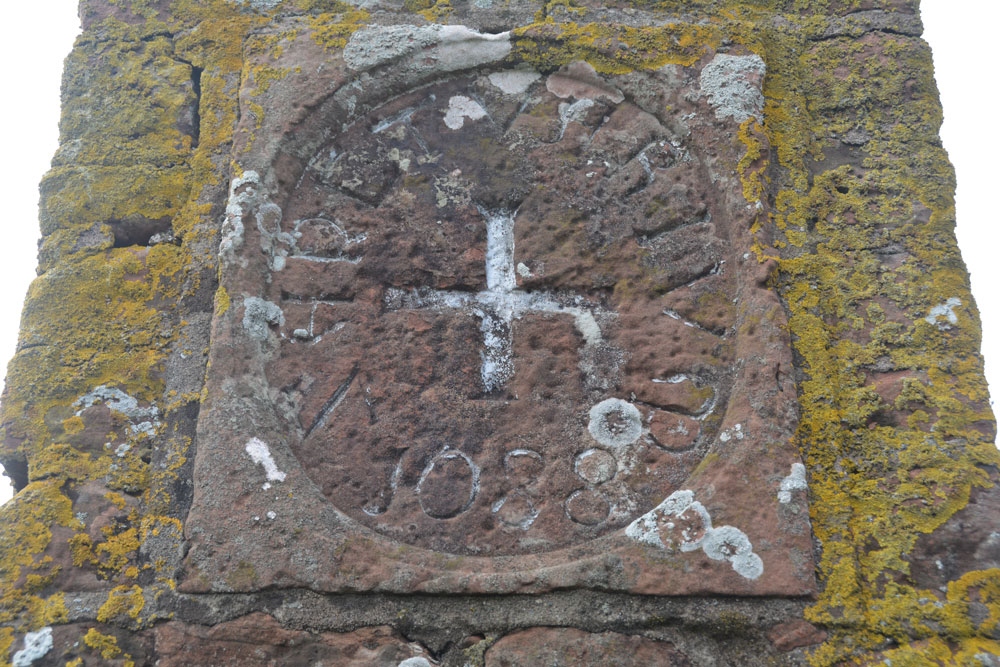
Cross House Incised Stone submitted by Anne T on 31st Jul 2018. The inscribed stone, now mounted in a 19th century pillar. The age of the stone is unknown, but it is believed to be the remains of an old wayside or boundary cross.
(View photo, vote or add a comment)
Log Text: Cross House Incised Stone, Staffield: We parked at NY 53519 43219, where a gate lets you into the footpath which goes down the hill, and joins a second footpath to Chapel Well. We walked back up the hill towards Cross House. The pillar was just visible through the hedge. We let ourselves in to the field by the gate near Cross House (there was no-one around to ask) and quickly walked to the pillar to photograph the cross.
Interesting that HE classes this as a sanctuary cross, and Pastscape as a possible wayside or boundary cross.
On processing the photographs to post to the Portal this morning, I realised we’d been to this site in October 2015, but hadn’t submitted a new site or photos to the Portal. I had asked the lady hanging out her washing in the garden of Cross House and she’d given us permission to go into the field.
Splendid views south over to the River Eden and the site of the old priory. The pillar was very near the hedge, , but it was still possible to get photos of the recut stone in its 19th century pillar.
Chapel Well (Staffield)
Trip No.90 Entry No.3 Date Added: 31st Jul 2018
Site Type: Holy Well or Sacred Spring
Country: England (Cumbria)
Visited: Yes on 30th Jul 2018. My rating: Condition 3 Ambience 5 Access 4
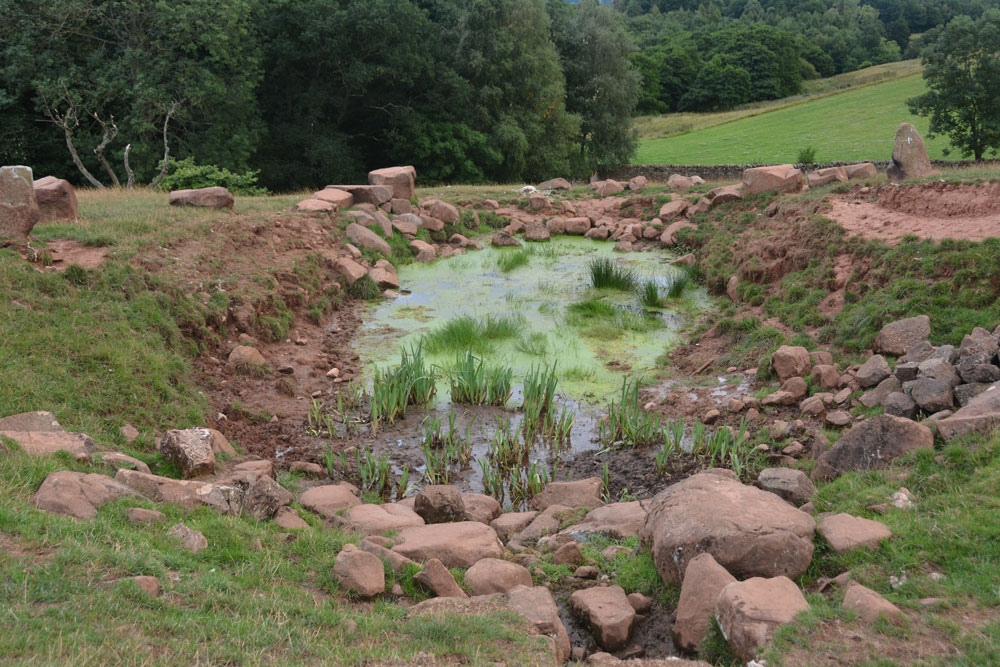
Chapel Well (Staffield) submitted by Anne T on 31st Jul 2018. The well with its pond, taken from the western end. The water bubbled out of the ground just in front of the stone bowl at the time of our visit, and was a fair flow. Between the well pool and the 'pond proper' were some lovely clumps of irises. Certainly peaceful and restful.
(View photo, vote or add a comment)
Log Text: Chapel Well, Near Staffield, Cumbria: Not far from the incised stone at Cross House. We parked near the junction down the hill where there was room to bump up onto the grass verge and walked to the gate at NY 53603 43081, which is signposted towards ‘Dale’. We kept the dry stone wall to our right hand side, and as we approached the gate into the wood, a stone drinking trough and a tree with a ditch leading from it came into view. Slightly up the slope there were some red sandstone boulders on the horizon, with a sheep track leading up to it.
The drinking trough is at NY 53774 43194 and is similar to the ones we saw at Newbeggin. The tree with its accompanying ditch is at NY 53778 43244, and there are signs of another stone structure under the tree, now dry and ruined, but possibly a secondary outlet for the well during wet weather. At the bottom of the slope, a small hole leads through the stone wall into Croglin Water just beyond.
This well is certainly in a lovely spot, hidden in a dip towards the top of the slope. There were two ‘standing stones’, one on either side of the large well pool; the rest of the large boulders had been quarried and placed around the top of the pool. A circular well bowl can be seen at the top, centre of the well, and a good flow of water came from the well (not as much as Powdonnet Well). Half a sheep had been left to rot at the south eastern end of the pool, which spoilt the ambience, and stopped me from exploring the exit pipe, but taking that away, we could have lingered for a long while. Beautiful!
Powdonnet Well (Morland)
Trip No.90 Entry No.4 Date Added: 31st Jul 2018
Site Type: Holy Well or Sacred Spring
Country: England (Cumbria)
Visited: Yes. My rating: Condition 3 Ambience 3 Access 4
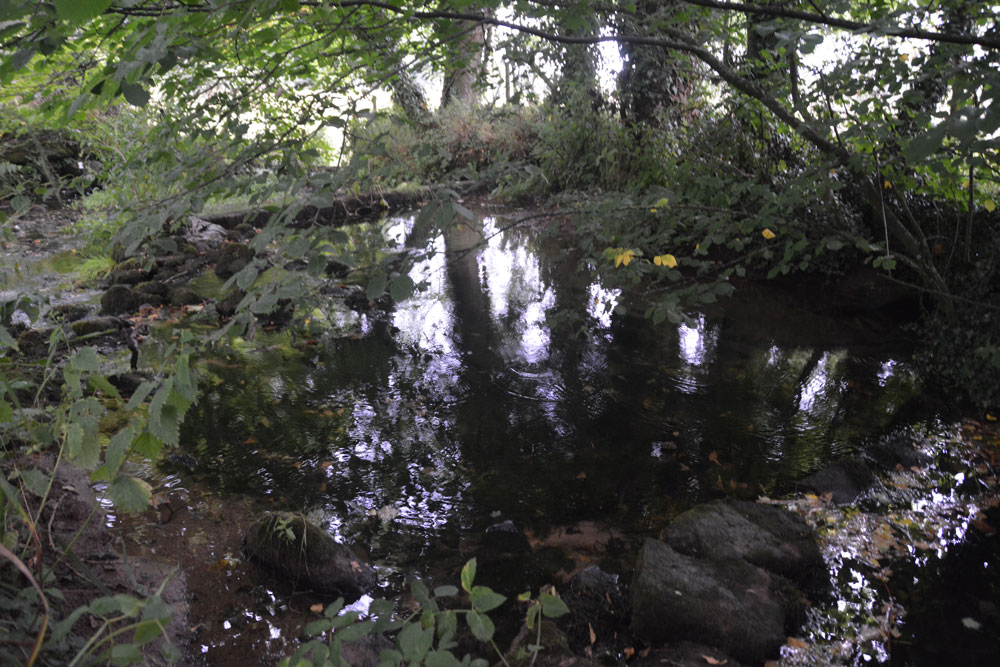
Powdonnet Well (Morland) submitted by Anne T on 31st Jul 2018. The well pool is clear and inviting. Parts of it, particularly under the tree to the right hand side of the photograph, look deep, but the stones at the bottom of the pool can be clearly seen. A little overgrown, and in the sunshine would be a lovely spot.
(View photo, vote or add a comment)
Log Text: Powdonnet Well, Morland, Cumbria: If not quite so overgrown, I'd have awarded this a '4: Good' rating on Ambience (despite the downpour after the long dry spell!). This well is marked on the OS map, but there is no mention in either Pastscape or HE.
The Holy Wells of Cumbria booklet describes this well as: “Morland. Location: Approx. 6.5 miles south east of Penrith. At the northern end of Morland village. Take road from Morland towards Cliburn. On right, as you leave village, opposite ‘Morland’ sign, is a small parking area. The standing stone and pool are close to the road.
The well had been neglected since the booklet was written in 2008 and we had to pick our way through the tangle of tree branches. We were just approaching the site of the well when the heavens opened, and there was an absolute downpour. Somewhat protected by the trees, we nevertheless decided to explore.
The easiest way to the standing stone and well is to find the overgrown footpath at the southern end of the bridge across the small stream which crosses under the road and joins the Morland Beck to the east of the well site.
The water in the pool is crystal clear. The water really does appear from nowhere. We stood at the southern end of the spring, listening to the water rushing up from the ground. The pool has been created by a couple of stone/concrete dams across the spring just to the northern part of the site. A lovely place. Next time we visit, remember to bring pruning shears!
Bessygarth Well (King's Meaburn)
Trip No.90 Entry No.5 Date Added: 31st Jul 2018
Site Type: Holy Well or Sacred Spring
Country: England (Cumbria)
Visited: Yes on 30th Jul 2018. My rating: Condition 3 Ambience 4 Access 4
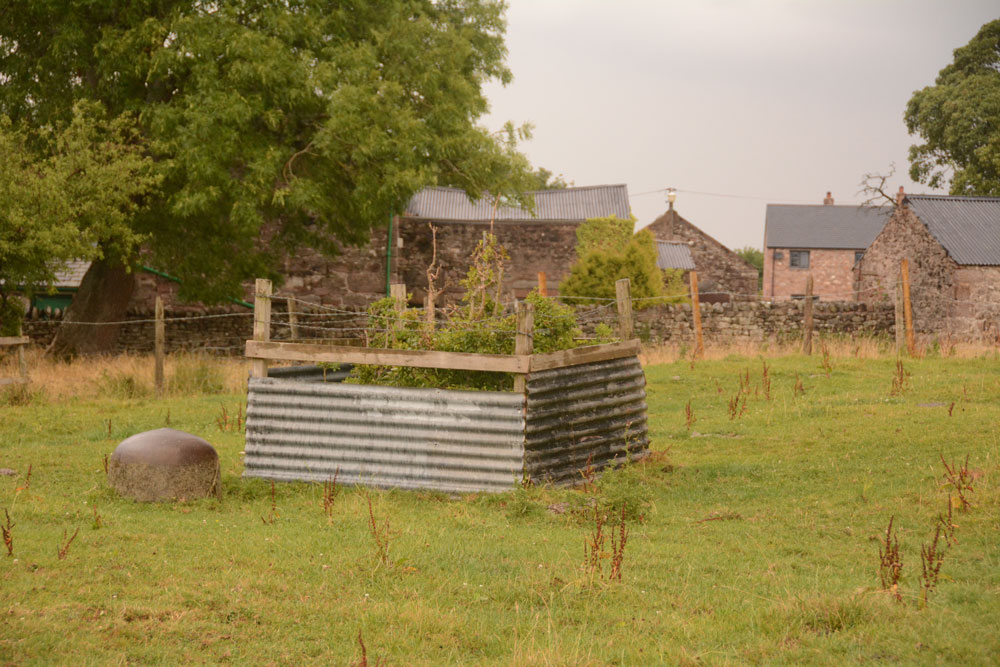
Bessygarth Well (King's Meaburn) submitted by Anne T on 31st Jul 2018. Getting closer, the peculiar cast iron 'bowl' (the cap for an old pump?) can be seen to the left hand side of the well. Thinking this was a drinking bucket for cattle/sheep, I tried to overturn it to look closer, only to find it was deeply embedded in the ground, and very heavily constructed.
(View photo, vote or add a comment)
Log Text: Bessygarth Well, King's Meaburn: This is a very old village, with a scheduled 17th century barn opposite the bus stop next to the village hall where we parked. The village runs in a long ribbon along both sides of the road, with an incongruous caravan park tucked behind the village hall.
Despite being marked on the OS map, we couldn’t find this well at first, so asked someone who’d pulled up outside one of the cottages opposite. He was only visiting, but was kind enough to ask inside the house, and relayed a message, saying that “if there’s some old tin in the field, that’s the well”. We were told it was OK to go into the field, providing we ensured the gate was shut.
Andrew dropped a stone down it, and it sounded deep! There was a most peculiar solid cast iron ‘bowl’ deeply embedded into the ground next to the well. Was this the cap of an old pump?
The field behind the well is covered in lumps and bumps. Researching it when I got home, found it was the site of the medieval settlement.
St Bridget's Church (Bridekirk)
Trip No.91 Entry No.5 Date Added: 18th Aug 2018
Site Type: Ancient Cross
Country: England (Cumbria)
Visited: Yes on 14th Aug 2018. My rating: Condition 3 Ambience 4 Access 5
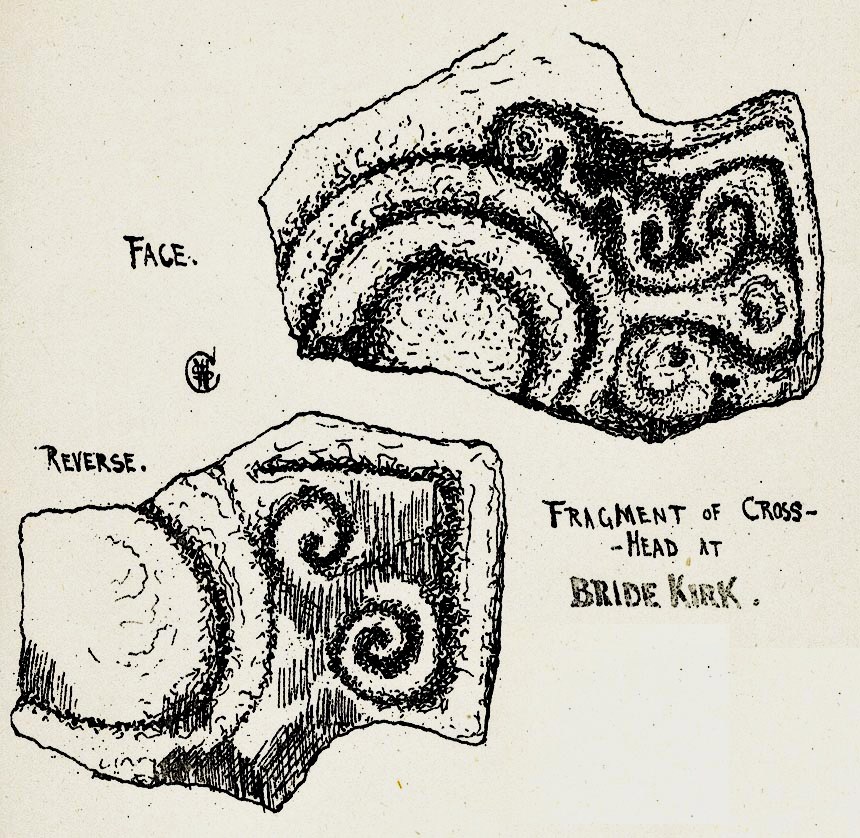
St Bridget's Church (Bridekirk) submitted by Sunny100 on 19th Apr 2011. Illustration of The Cross-Head fragment at St Bridget's Church, Bridekirk, Cumbria, by Rev William Slater Calverley 1847-98.
The above image is from his renowned work 'Early Sculptured Crosses, Shrines and Monuments in the Present Diocese of Carlisle 1899 Ed. by W.G. Collingwood.
(View photo, vote or add a comment)
Log Text: Font with Runic inscription, St. Bridget's, Bridekirk: We had an hour to fill between appointments between churches, so headed off to Bridekirk to see the font with runic inscription, which we'd missed during our last visit on 1st May 2015. The notice said the church was "normally open during daylight hours" but on this occasion the main door appeared to be bolted at the top from the inside, so we couldn't get in. This time, not having a six month old granddaughter with us, we walked round the outside of the church and noticed a collection of old grave slabs displayed against the exterior of the apse at the east end of the church, including an old cross base. None of these in mentioned on Pastscape.
Checking back in my photos, I had taken a photograph of the font. The middle band (when enlarged) does indeed have a runic inscription on it.
St Mungo's Church (Bromfield)
Trip No.91 Entry No.1 Date Added: 15th Aug 2018
Site Type: Ancient Cross
Country: England (Cumbria)
Visited: Yes on 14th Aug 2018. My rating: Condition 3 Ambience 4 Access 4

St Mungo's Church (Bromfield) submitted by Anne T on 10th Jul 2018. The dark red semi-circular stone is (the remains of) AS Corpus Bromfield 04, a 10th century hogback, as seen from the inside of the south porch. Located above the main door of the church, we stood for ages trying to make out the original hogback. The wavy edge at the top of this dark red sandstone is the only clue. According to the AS Corpus photos, the hogback can be better seen from inside the church, but the church was locked, so we were unable to see.
(View photo, vote or add a comment)
Log Text: St Mungo's Church, Bromfield: We'd arranged with the church warden for the church to be left open for us for an hour or so this morning, so this was our first stop on a 'five church stop' tour. We were looking forward to finding cross head and cross shaft fragments, and to being able to see the reverse side of the hogback stone above the doorway.
Whilst it looks quite daunting from the outside, the inside of the church is lovely, with some unique features, such as unusual corbels and the chancel arch, which is 'transitional between Norman and Gothic styles'.
I found the cemented remains of the cross head cemeted to the west end of the north aisle, and had to remove umbrellas and a carpet sweeper to see it. It was very cobwebby, and looked sadly neglected.
AS Corpus Bromfield 02 was in two pieces. There was a collection of old stones in the north transept, and we needed to move a low bench and a collection of chairs to be able to see this.
The hogback from the other side (inside the church) was much more convincing, and there was also a consecration cross on the right hand door jamb of the south door. Well worth returning to see.
St Mary's Church (Gilcrux)
Trip No.91 Entry No.2 Date Added: 16th Aug 2018
Site Type: Ancient Cross
Country: England (Cumbria)
Visited: Yes on 14th Aug 2018. My rating: Condition 3 Ambience 4 Access 5

St Mary's Church (Gilcrux) submitted by Anne T on 10th Jul 2018. We may not have been able to see the Viking cross head and shaft fragment, but we did spot this underneath the window in the southern external wall of the sanctuary. The notes inside the church say it is the remains of a grave slab, recut for use as a lintel.
(View photo, vote or add a comment)
Log Text: St Mary's Church, Gilcrux: The little car park outside the church was full (3 cars and a Water Board van), so we had to park just west of the well and walk back to the church – only a little way. The church door was open for us this time.
This is a remarkable little church inside. At first site, the nave appears more like a Methodist chapel – at first glance. Then my gaze lit on the archway into the chancel, with a ‘squint’ over the right hand column and a chunk taken out of the eastern side of the left hand column. Walking into the chancel is very reminiscent of Escombe Saxon Church – this place is ancient and very peaceful.
The collection of stones was underneath a table against the south wall, near the porch, so we turned into furniture removers, carefully taking the notice board, vases and loose notices off the table, then moving the table to examine and photograph the pieces.
We managed to put together the pieces of the cross head and part of the shaft, and photographed two sides. One of the pieces left white, chalky marks on our hands, and is very white against the grey of the other two pieces. This is clearly the cast of the upper part of the cross head.
We closed the church door to indicate to the keyholder we’d been in and left again, and walked round to the north side of the church, where it is very obvious that the church has been built on a mound.
There was no church guide book, but there were some ‘notes for visitors’ which I photographed, and have typed into my walk journal.
The spring was in full flow, and it was lovely to hear it babbling away. Brilliant. Definitely worth a return visit.
St John The Evangelist (Crosscanonby)
Trip No.91 Entry No.3 Date Added: 17th Aug 2018
Site Type: Ancient Cross
Country: England (Cumbria)
Visited: Yes on 14th Aug 2018. My rating: Condition 3 Ambience 4 Access 5
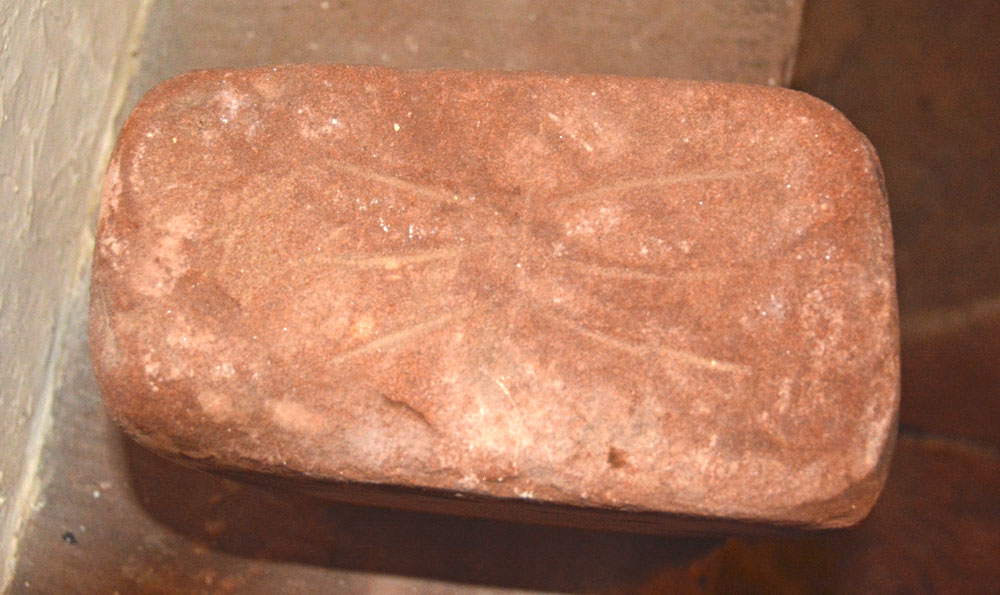
St John The Evangelist (Crosscanonby) submitted by Anne T on 17th Aug 2018. Face D of AS Corpus Cross Canonby 03, also known as The Thunder Bolt Stone. The Corpus tells us this face shows: "the incised ornament consisting of a single horizontal line on which converge three incised lines from above and below." This is the famous 'thunder bolt' symbol.
(View photo, vote or add a comment)
Log Text: St John The Evangelist, Crosscanonby: We had arranged to meet the Reverend Mary at the church at 2pm. Between Gilcrux and here we had an hour to spare, so went into Cockermouth for lunch and a quick walk round the town. Travelling through Dearham and across the A596 to Crosscanonby, as we dropped down a small hill after having crossed the A596, we realised how close this church is to the Solway Firth (according to UK Grid Finder measurements its 900m).
This little church is side on to the road, and is virtually invisible until you reach the gate into the churchyard, although the ‘this church is open’ board gave something away.
I’d not looked at the AS Corpus notes I’d brought, but straight away we spotted the hogback against the south eastern corner of the nave.
Walking inside was a real treat. This is clearly a very old building. Reverend Mary (just ‘Mary’ she said) told us this church used to be the mother church for Maryport and the farm house next door (to the west of the church) used to be part of the monastery; the monks used to process from the monastery to the church; rumour has it there is a tunnel from the farmhouse to the church, but it’s never been found.
The church is pretty special, although I focussed on photographing the stones in the porch whilst Andrew spoke to Mary about the structure of the building, as I was conscious of taking up Mary’s time and we needed her to come across to Dearham to open the vestry for us. I’d love to go back and spend more time here.
St Mungo's Well (Cumbria)
Trip No.91 Entry No.8 Date Added: 18th Aug 2018
Site Type: Holy Well or Sacred Spring
Country: England (Cumbria)
Visited: Yes on 14th Aug 2018. My rating: Condition 3 Ambience 4 Access 4
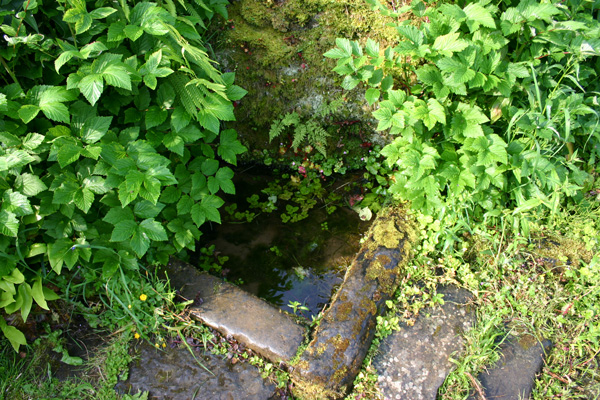
St Mungo's Well (Cumbria) submitted by ocifant on 26th Jun 2005. Looking at the various maps, the location of this well is difficult to discern. It's actually easy to find once you get to the church though.
From St Kentigern's in Caldbeck, walk through the churchyard from the road, and exit via the rear gate. Cross the footpath to the river. Immediately on entering the river path, there are a couple of steps down to the riverbank. These lead to the well.
(View photo, vote or add a comment)
Log Text: St Kentigern's Well, Caldbeck: This was our last stop of the day, and to a part of Cumbria we've never travelled through before. From St. Bridget's in Brigham, we followed the B5299 to Caldbeck village, which took us over cattle grids and moorlands, with only sheep and the occasional other car in sight.
Caldbeck is a really pretty little village, and we resolved to come back during the daytime, when the shops, church and café were open.
The well can be easily found by walking down the footpath to the west of the church, until you get to the bridge over the river. As it says in the "Holy Wells of Cumbria" booklet, turn left just before the bridge, and you immediately come to some steps down the (steep-ish) bank to the river. We heard the trickle of water down the slope, and the well basin comes into view as you look down. At the time of our visit the water missed the basin and was trickling down the rock, under the shrubbery, into the river. There was a fair flow of water coming down the bank.
We walked along the footpath along the northern side of the churchyard for about 100mand found a lovely weir with small waterfalls. It was possible to walk down to the gravel beach. A lovely spot indeed.
St Bridget's Church (Brigham)
Trip No.91 Entry No.7 Date Added: 18th Aug 2018
Site Type: Ancient Cross
Country: England (Cumbria)
Visited: Yes on 14th Aug 2018. My rating: Condition 3 Ambience 4 Access 5
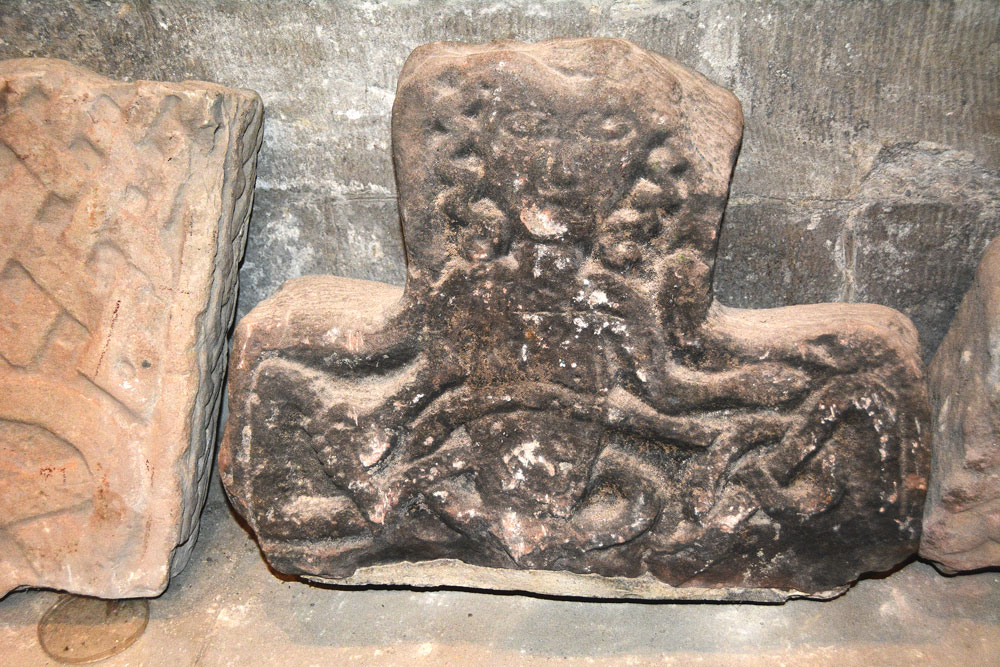
St Bridget's Church (Brigham) submitted by Anne T on 18th Aug 2018. This is Brigham 05, part of a cross-head dating to the 10th century. It was first recorded in 1881, presumed to have been found in restorations of 1864 or 1875-6. Note the curly haired naked figure, with his right hand and a snake (or interlace) bound across his stomach. His left hand is described as having an open palm, lying above the interlace of the right arm.
(View photo, vote or add a comment)
Log Text: St Bridget's, Brigham (Anglo Saxon Stones): Whilst this church looks very austere from outside, and the entrance doors dark and foreboding, once inside the church, it is a completely different picture – this church is light, airy and welcoming. The painted ceilings are fantastic.
The church warden turned up as arranged, and was so welcoming. He sought out a guide to the church and old postcards for information, then left me photographing the stones whilst Andrew walked round the church with him.
Time was all too short here, and I could have spent another hour, but we knew the church warden needed to get home, and the evening traffic was building up outside. In our haste, we missed Brigham 13, a cross base at the west end of the church (I thought I’d photographed it, as we went through all the AS Corpus pages I’d brought with me, but realised (too late) it wasn’t the correct stone).
After looking at the Fletcher family grave (now very worn and held together with large staples, I walked over to the west end of the churchyard to look at the farmhouse, which used to be the rectory for the farm).
We also looked for the site of Nun's Well, but were unable to see anything.
